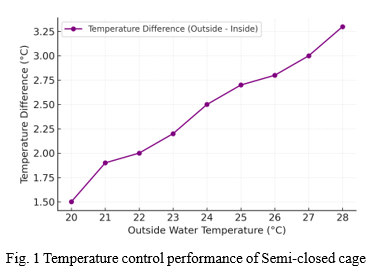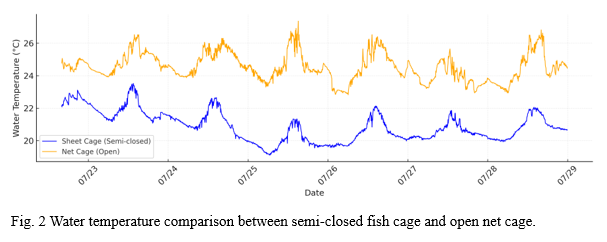INTEGRATED NUMERICAL AND FIELD ANALYSIS OF WATER ENVIRONMENT CONTROL INSIDE A MARINE SEMI-CLOSED RECIRCULATING FLEXIBLE FISH CAGE
Introduction
The offshore net cage aquaculture industry is increasingly challenged by environmental stressors such as red tides, parasites, and elevated surface water temperatures (Price et al., 2015; Sun et al., 2024). Semi-closed recirculating fish cages are gaining attention as a promising solution to mitigate these issues by physically isolating the cultured environment from surrounding seawater and introducing cooler water from deeper layers. However, understanding and controlling the internal water environment, including water temperature, dissolved oxygen, and salinity—is crucial for improving fish welfare and farming sustainability.
This study focuses on numerical simulation with field experiments to investigate the environmental control performance of a semi-closed recircula ting flexible fish cage . The findings aim to provide a scientific basis for optimizing system design and operational strategies.
Materials and methods
A three-dimensional numerical simulation was conducted by using the MEC (Marine Environmental Committee) Ocean model (Zhang and Kitazawa, 2015) , incorporating surface radiative heat exchange and wall heat conduction effects, to investigate the internal temperature distribution of a semi-closed fish cage. The simulation domain is a sub-scale semi-closed fish cage measuring 5 m × 5 m × 3.5 m, with the lower 3 m shaped into a conical structure to facilitate waste accumulation and flow convergence. A structured grid with a uniform resolution of 25 cm was applied both horizontally and vertically.
Water inflow was applied at the top of the cage, while outflow occurred naturally through an open bottom without forced pumping. The temperature of the inflow water was set at 18 °C, representing cold water conditions. Seawater properties were assumed with a density of 1025 kg/m³ and a specific heat capacity of 4170 J/kg/K. At the surface boundary, radiative heat exchange was considered. The cage wall boundaries accounted for heat conduction between the internal water body and the external sea water.
Meanwhile, a field experiment was conducted using the same cage configuration in a coastal bay. Cold water (water tempera ture about 18°C) was pumped from 3 m depth and injected continuously at 250 L/min. Water temperature was monitored at multiple depths.
Results
Numerical simulation results demonstrate that as the outside seawater temperature increased from 20 °C to 28 °C, the temperature difference between inside and the outside of the cage also increased (Fig. 1). This highlights the system’s strong temperature adjust capacity under high-temperature conditions.
Field experiments further validated this performance. In a real coastal expetiment , we compared water temperature inside a semi-closed cage with that of a traditional open-net cage. The semi-closed cage maintained consistently lower temperatures than the open-net cage( Fig. 2). This experimental evidence confirms the system’s ability to mitigate heat stress and support a more stable thermal environment for cultured fish.
Conclusion
This study evaluated the environmental control performance of a semi-closed fish cage system through both numerical simulations and field experiments. The results revealed that the semi-closed cage effectively maintained a cooler and more stable internal environment. This temperature-buffering capability not only helps mitigate the risks associated with high summer temperatures but also supports a more consistent water environment to fish growth. These findings demonstrate the system’s potential for improving environmental stability in marine aquaculture.
Acknowledgement
This work was supported by the JST-Mirai Program Grant Number JPMJMI21C1 through the project “Development of Next Generation Sustainable Aquaculture System”.
References
Price, C., Black, K. D., Hargrave, B. T., & Morris Jr, J. A. (2015). Marine cage culture and the environment: effects on water quality and primary production. Aquaculture environment interactions, 6(2), 151-174.
Sun, M., Bi, C. W., & Huang, L. (2024). China’s mariculture net cages in typhoon and sea ice disasters: challenges and prevention strategy. Sea Exploitation and Environment, 1(01).
Zhang, J., & Kitazawa, D. (2015). Numerical analysis of particulate organic waste diffusion in an aquaculture area of Gokasho Bay, Japan. Marine pollution bulletin, 93(1-2), 130-143.

